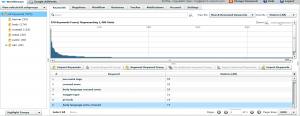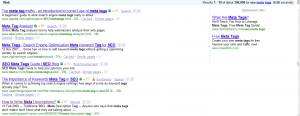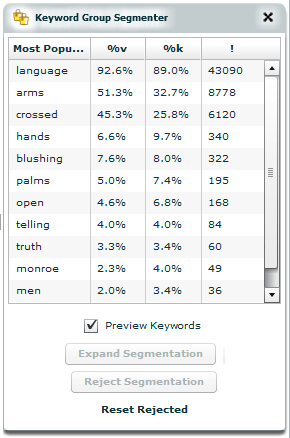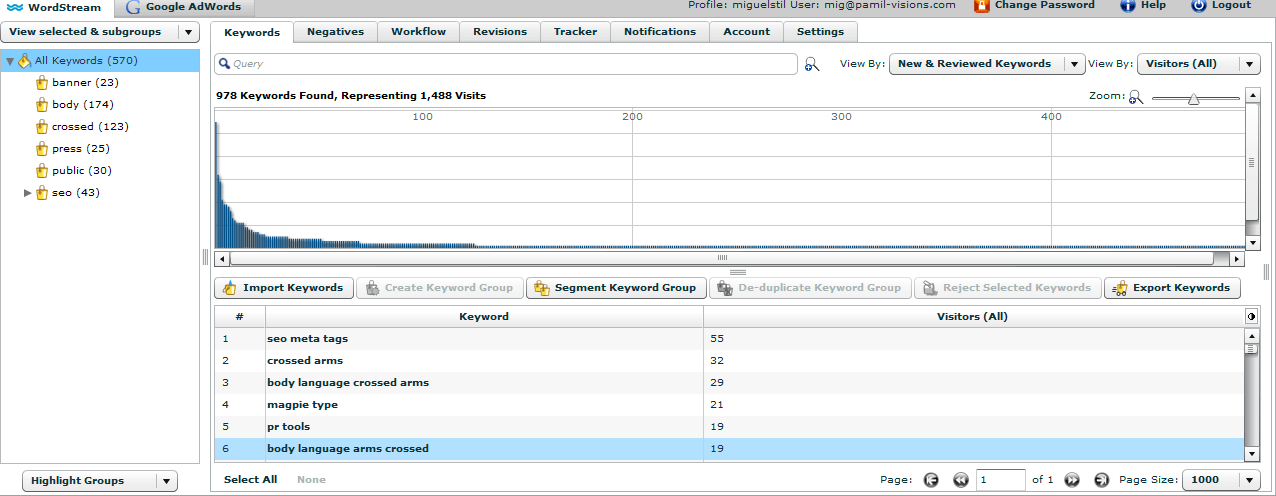I rarely get excited about SEO and SEM tools – mostly because I am not a fan of anything that “automates” a type of work that should actually be carefully tailored according to customer needs, market trends, and etc. SEO software makes a lot of our jobs easier, and there are some situations where the results would be mediocre without such tools. The types of “SEO software” I always reject are the types that might actually produce damage to a site: automatic search engine submissions (the type of “submit your site to over 300000 search engines” for example), automatic directory submitters, automatic article submission (spamming a number of ezines with the same content), etc.
But, when it comes to keyword research it is virtually impossible to produce a quality worksheet without software. Keyword discovery and suggestion software, even in their free versions, are life savers. However, this type of software only produces a list of “most popular” keywords – that can be worthless without careful filtering by the marketer who is actually going to use them for a SEM – PPC campaign. The filtering is the most time consuming process. I don’t know how other SEOs work, but I manage my keywords with Excel, creating large spreadsheets of information, trying to determine from one week to another which keywords performed best (based on Google Analytics and others), and having to update that list manually each time.
When I have to perform the same task for my customers, the process is even more daunting and time consuming. This long introduction has a point: there is now a better way to manage huge keywords lists and this “tool” is called WordStream.
I was given a one hour demonstration of the software by Larry Kim, the man who created WordStream. He was very disappointed to hear that I was not into PPC (as a PR I can “read” reactions even from the distance) – probably thinking that I would not understand the software and how important this is for an SE marketer, but he went on answering all my questions, despite this apparent drawback. I think Larry made this to help PPC managers more than anything else, but the software is much more complex, to be frank. I will actually go on ignoring PPC completely in this review – because obviously PPC is not my strength, and because, actually, I came to the conclusion that WordStream can be of use to anyone who wants to push their sites into the Google organic search results for keywords that actually bring traffic.
“Keyword tool estimates are ridiculous. WordStream on the other hand lets you map your keywords to real outcomes on your site, like visits and conversions. PPC and SEO campaigns based on real data work far better than those based on estimated of made-up data.” – Larry Kim, WordStream
I don’t think WordStream is effective for new sites. I see the main benefit of using this software once you have a well established site, a site with let’s say more than 100 pages and most importantly a dynamic site, one that you add content to on regular basis. Some types of sites are: blogs, commercial sites, news, forums, video, user generated content, etc. For these sites, WordStream will actually help the SEO handle a huge amount of information. For any other sites, paying for a tool designed to handle complex information is a waste of resource – and we have to consider resources in such hard financial times.
It took a long time to test WordStream because I used my personal blog for this purpose – a publication I don’t spend much time on (improving, SEOing or writing for) anymore, nevertheless a good test case for this software. I wrote on this site about everything from public relations to SEO and body language, so naturally I had to create different worksheets for each of these categories to monitor keyword performance. I remember once having to create worksheets with “dead” keywords as some popular phrases lost traction, just to see what used to be hot, and how the trends change or come back over time. As for keyword segmentation, this used to prove even more difficult, what with the manual insertions of spreads and other variations. For clients, the exactness of these methods has proved even more necessary obviously.
This is where WordStream actually proves its value – and I have to apologize one more time for being long winded, but perhaps the youngest SEO colleagues needed an in-depth picture of what it takes to provide a professional, comprehensive keyword report to a customer: right now hours and hours of manual work, with WordStream a few minutes, and a click of an “Export” button.
 Click on the image to enlarge.
Click on the image to enlarge.“One of the challenges in keyword research is keeping it up to date. Once you’ve grouped and organized all your keyword data in say, Microsoft Excel, how do you update that data? WordStream provides a simple way to automatically organizes new keyword data into your existing keyword research, so your keyword research is always current.” – Larry Kim, WordStream
WordStream handles keyword lists that can be thousands or hundreds of thousands of words long. The software, based on parameters you set, will then segment these keywords into groups. These groups will then help the SE marketer write compelling SEO copy based on those keyword phrases that are actually most performing and optimize pages for other keywords that are not that strong. For PPC this could drastically improve quality scores, but since I promised not to talk about PPC, consider that all your pages should actually have a high quality score to matter in the SERPs. A quality score is actually given by the page relevancy to a search query. The search query represents (usually) the very keyword phrase that brought the visitor to your site.
So, use WordStream to see where your site is listed for the keyword phrase that brings the most visits. For example, in my site’s case, “SEO Meta Tags” brought about 55 visits since I installed the WordStream tracker. Google.com shows my site at number 6 as I write this (and please consider that I search from Germany. Results may vary according to your geographical location).
 Click to enlarge.
Click to enlarge.I am happy with the first page for this term, so let’s see what other “SEO” related keyword phrases bring traffic to my site, and what I should improve. What about “free SEO ebook” – which lists my blog only on the third page in Google.com now? Considering that the reason why I offer a free SEO book on my site is precisely to increase traffic, only 1 visit in one week is not encouraging. The quality score of the page listed in Google.com for this particular keyword phrase must be very low. Before WordStream I wouldn’t have even noticed a keyword phrase like “free SEO ebook” – I would have normally listed only the best performing keywords and dumped everything else. But the problem is that “free SEO ebook” is something I “want to sell” – so the “dumping” is not a good idea. The only logical solution is: improve page to improve SEO quality score.
 Click to enlarge.
Click to enlarge.“Most keyword tools produce long lists of keywords. These aren’t actionable. We include an integrated keyword workbench for conducting keyword analytics, keyword research, negative keyword discovery, keyword grouping & organization, PPC & SEO workflow tools, and tools for taking action on keyword research.” – Larry Kim, WordStream.
 Writing here a full “how to use WordStream” is pointless, since the tutorial is already present on WordStream.com. But from the example above it should become pretty obvious how using this tool could help SEOs have a better overview of the best performing keywords. The beauty of the tool is actually managing keywords into groups, and even being able to determine “segments” of keywords for each main “group category.” The tool expands the keyword database continuously, based on an action tracker you set up into the WS account. This “expansion” will include negative keywords too and the process will be continuous, helping you actively monitor those trends I described at the beginning.
Writing here a full “how to use WordStream” is pointless, since the tutorial is already present on WordStream.com. But from the example above it should become pretty obvious how using this tool could help SEOs have a better overview of the best performing keywords. The beauty of the tool is actually managing keywords into groups, and even being able to determine “segments” of keywords for each main “group category.” The tool expands the keyword database continuously, based on an action tracker you set up into the WS account. This “expansion” will include negative keywords too and the process will be continuous, helping you actively monitor those trends I described at the beginning.
No, I am not a PPC marketer, but I learned, in the four or five occasions when I actually managed (fortunately successfully) AdWords campaigns for my customers, that SEO and PPC are complimentary. You cannot have a quality score for an AdWords campaign without SEO, and you cannot write compelling PPC ads without understanding how SEO works either. So, while it was designed with PPC marketers in mind, this tool should actually be used for all SEOs, especially when delivering up to date keyword performance reports to a customer is a priority.




